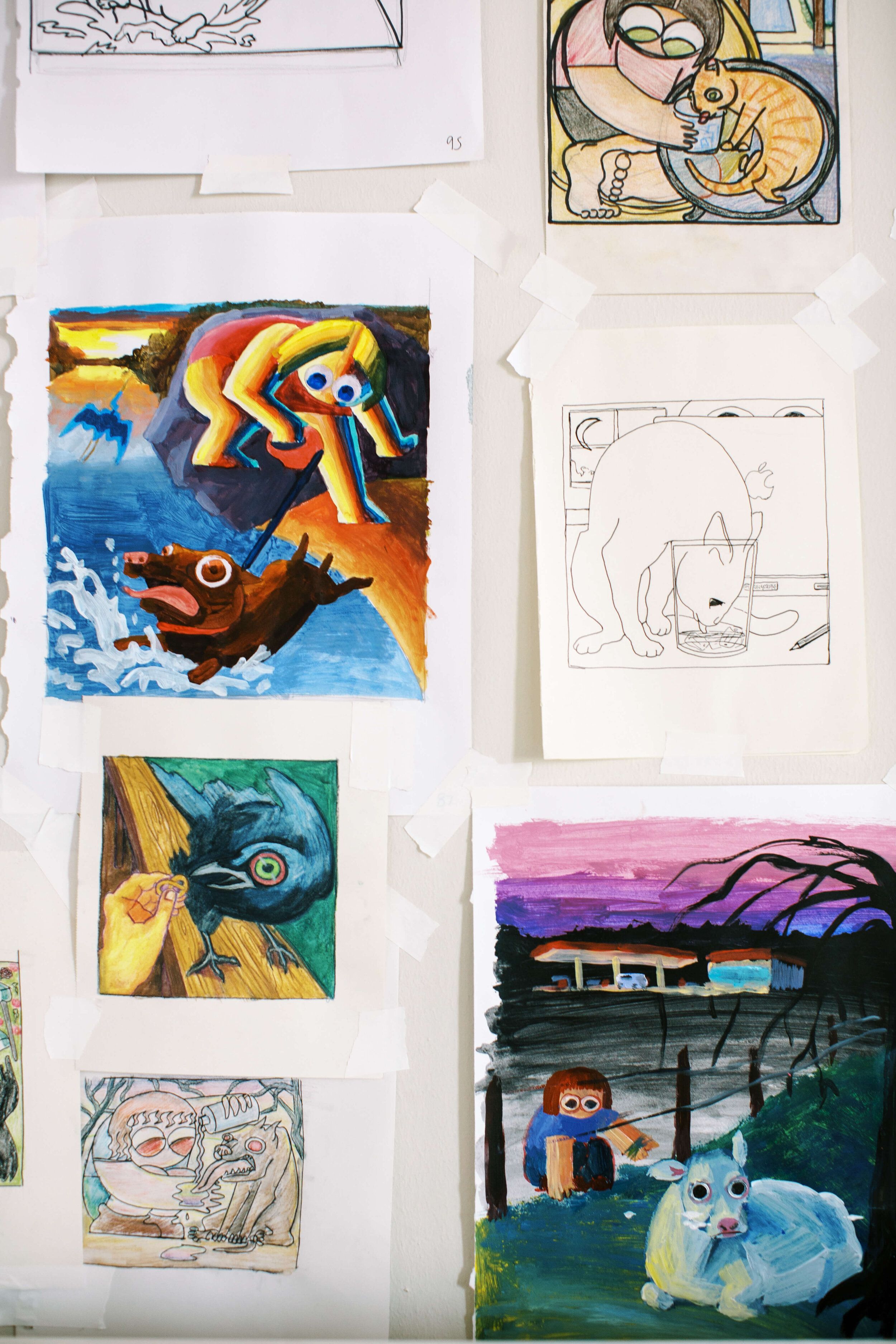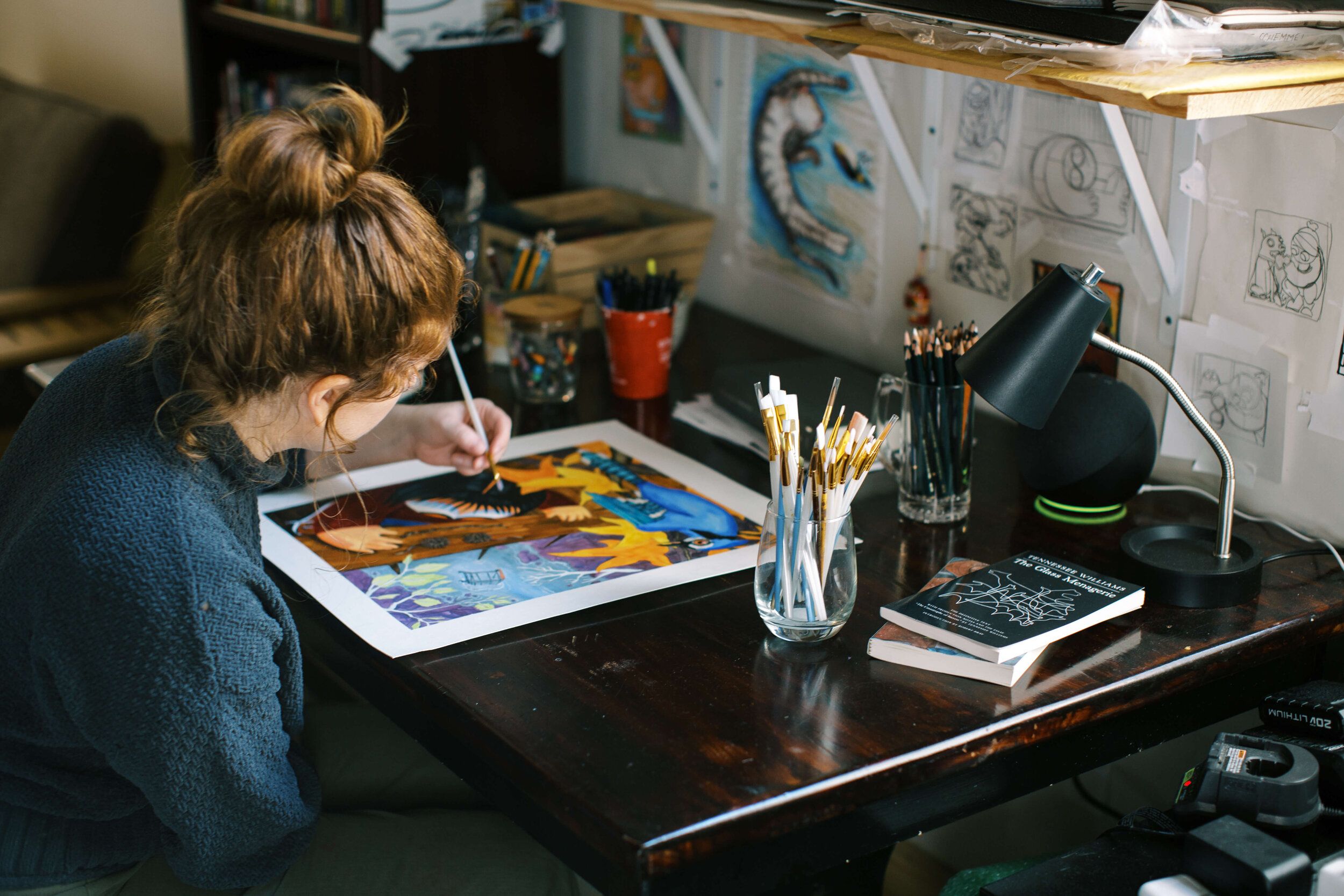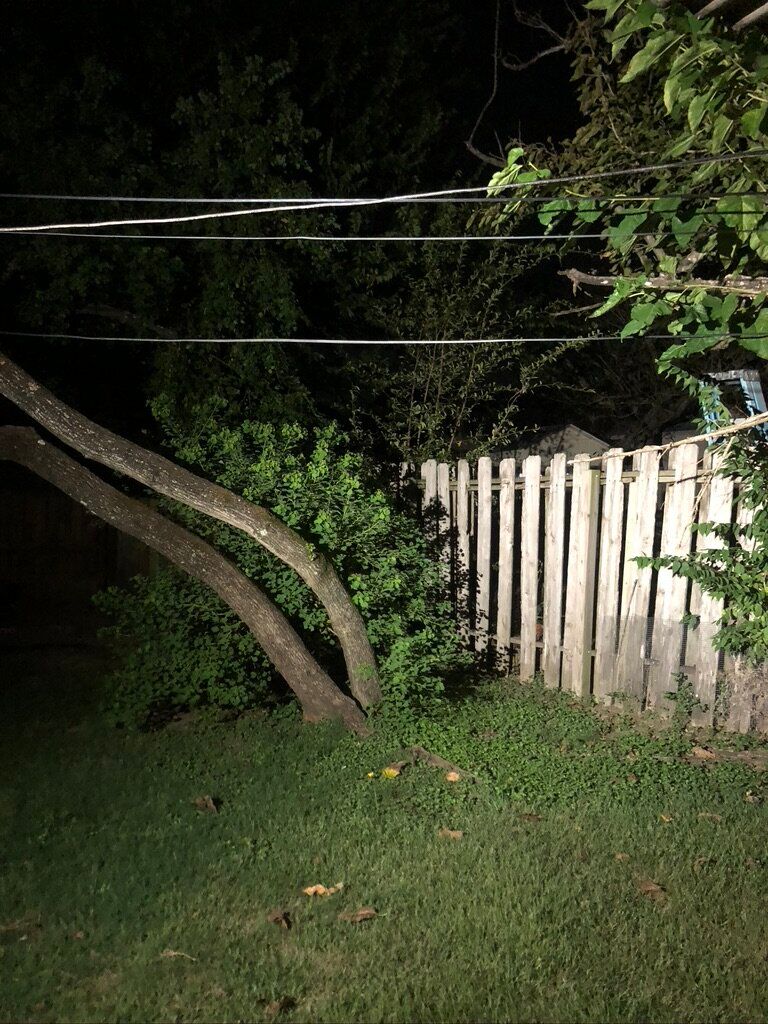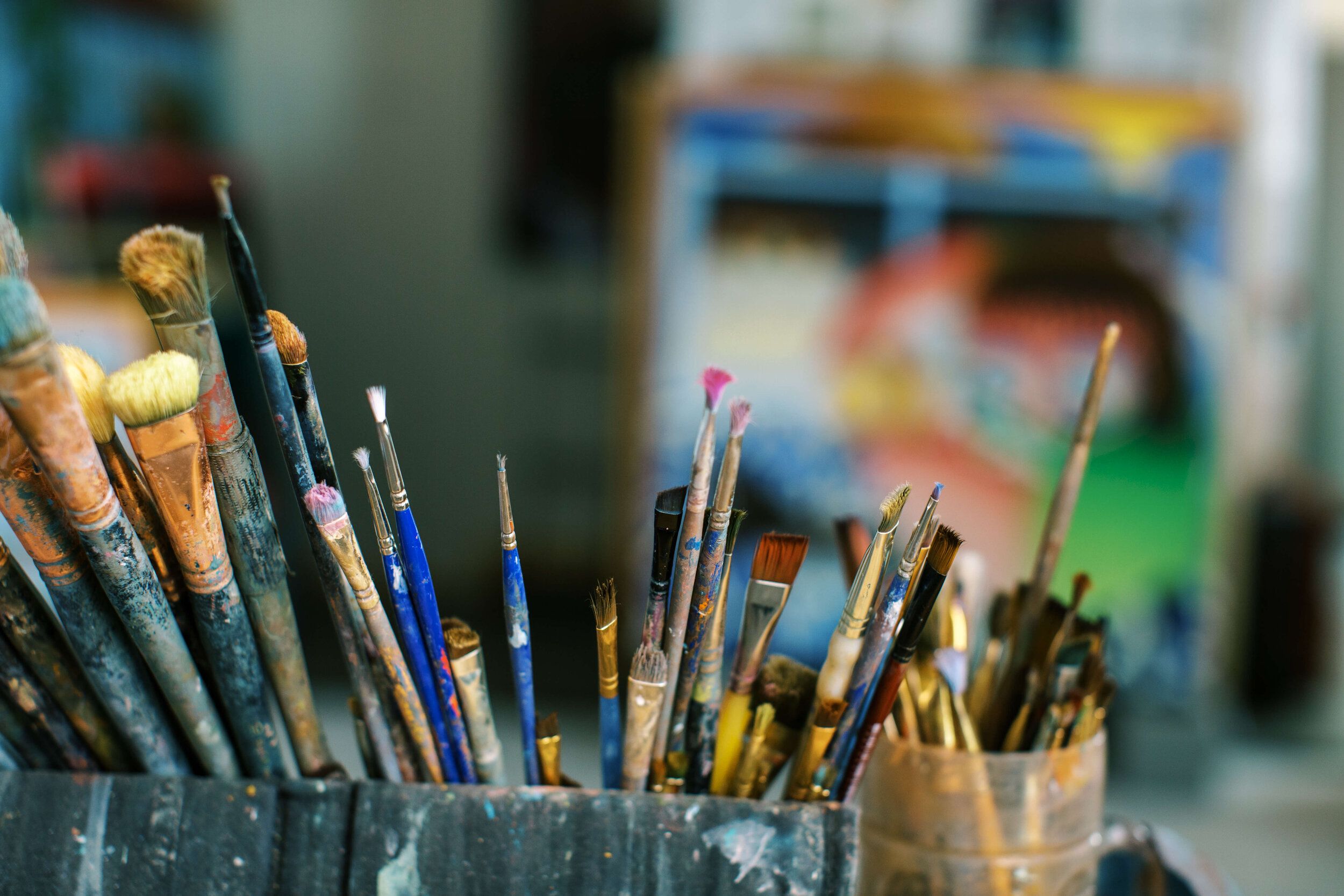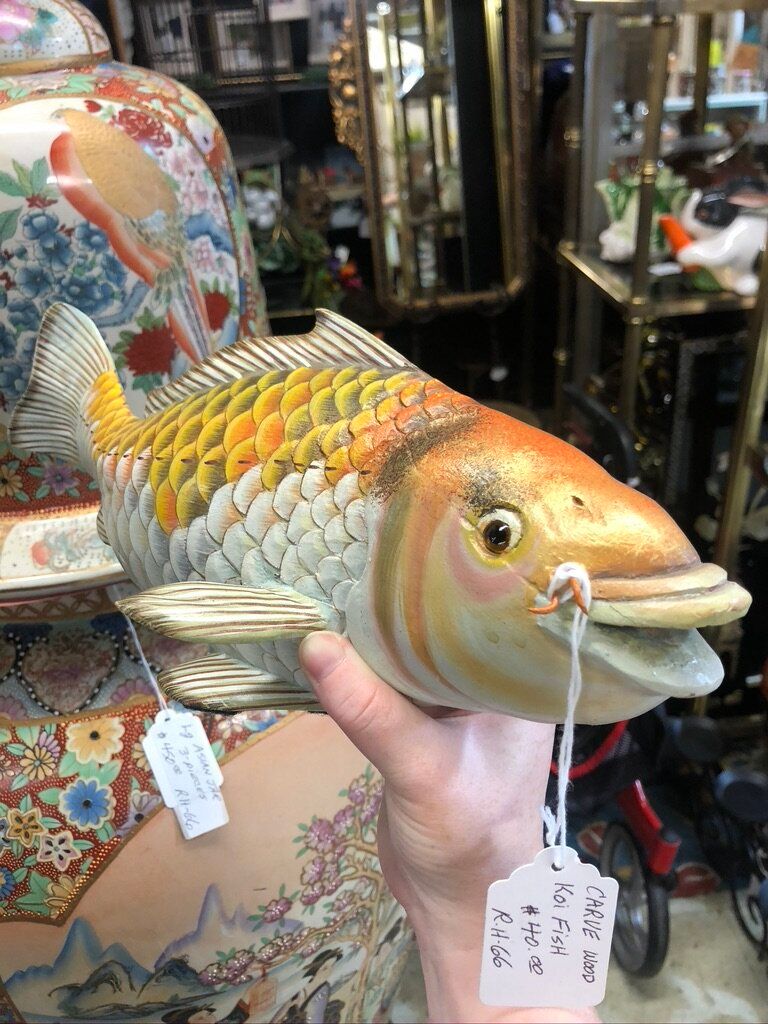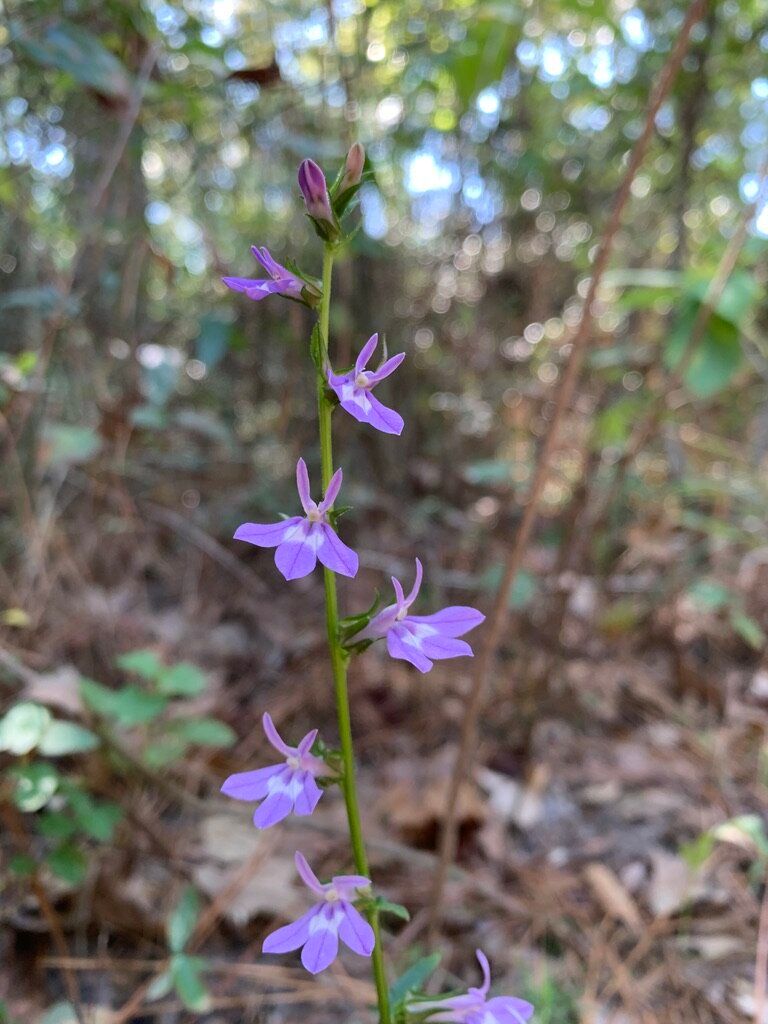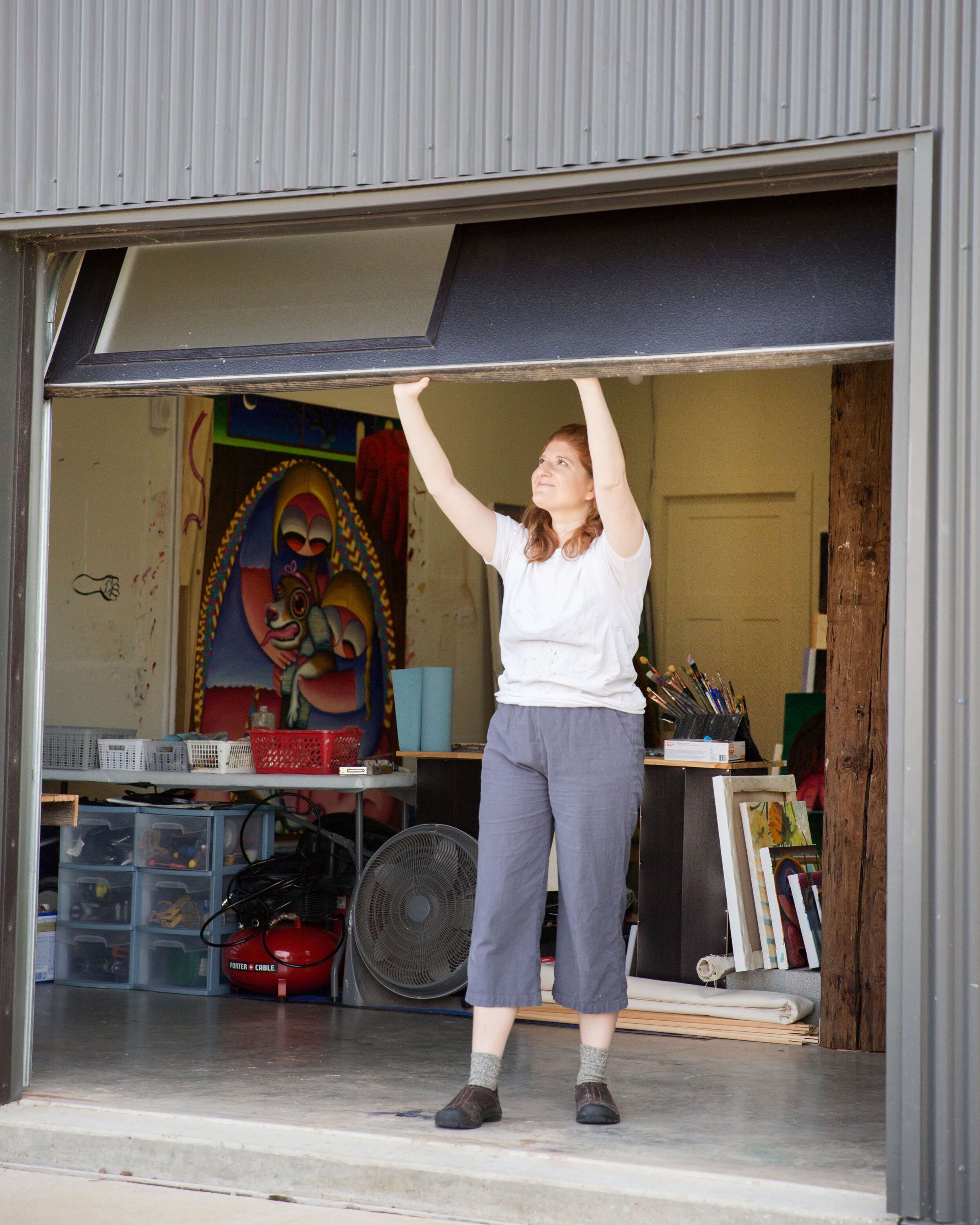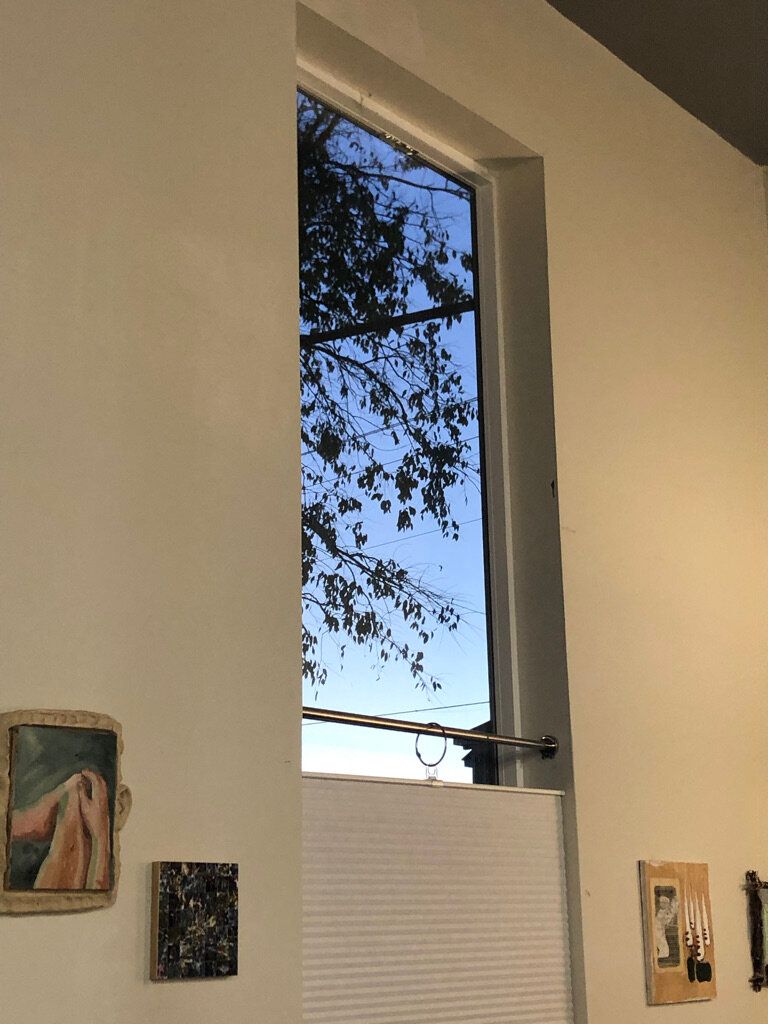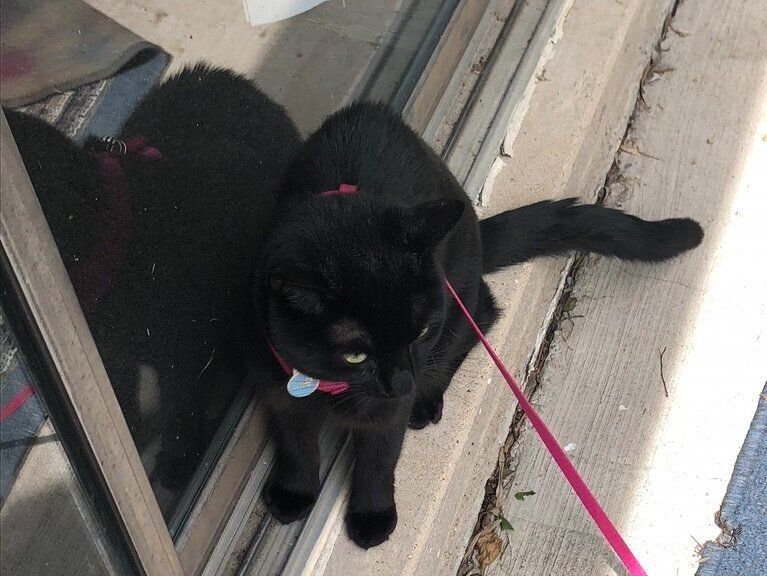
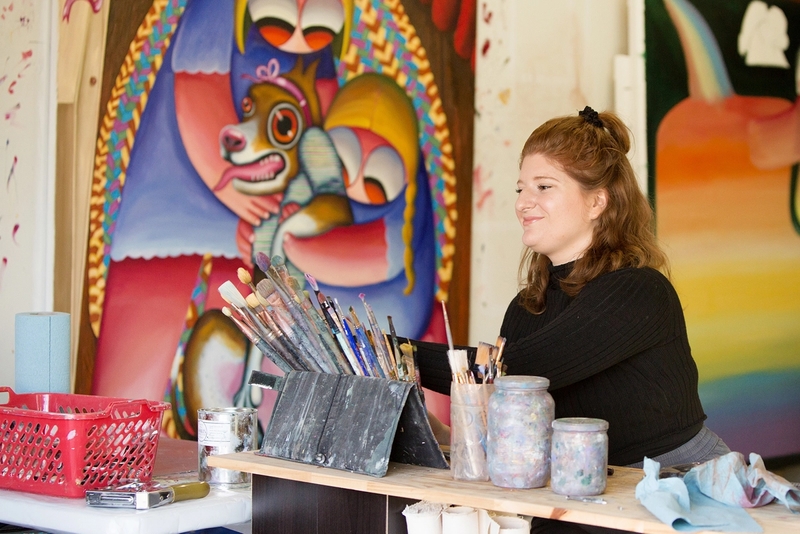
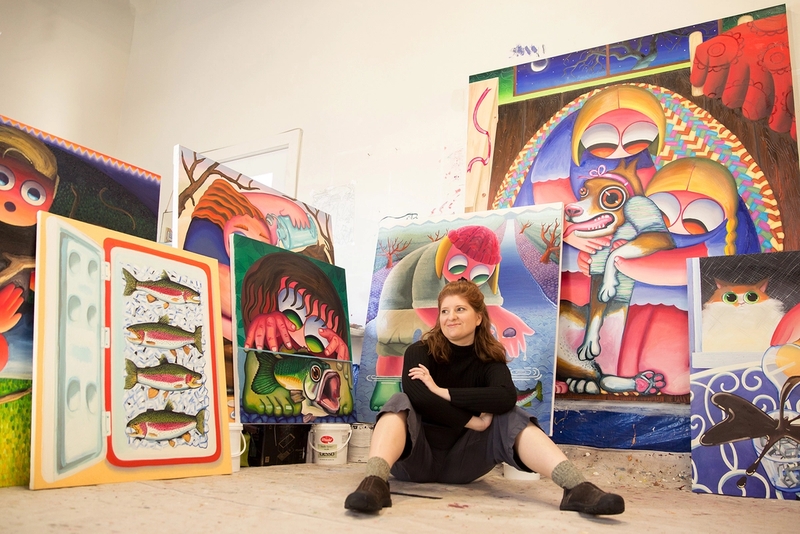
Anatomy is a platform that dissects and narrows in on the various parts of an artist’s practice through the lens of their studio. This presentation will provide a glimpse into an artist’s background and process through a multimedia tour including video, audio clips, imagery, and conversations with fellow artists, curators, and other figures who have been influential in shaping and understanding these creators and their works. Anatomy's intent is to examine the myriad of ways in which an artist finds inspiration, merges art and life, and is driven by experience and the people that come into their world. We hope that this glimpse into the lifeblood of the artist’s practice will affect an even deeper reading of the works included and those yet to come.
Background

Anatomy: Natalie Wadlington features new paintings by the Texas-based artist, who creates vibrant oil paintings that are based in story-telling and figuration. Her characters are wide-eyed with wonderment and fear as they navigate various environments and encounters with both wild and domesticated animals. Within her paintings, humans and animals come together in symbolic scenes that mirror our own complex interpersonal struggles for understanding.
Wadlington’s works are layered in their defense of our innate connection to other species in the natural world, which is an idea she reinforces through each aspect of the painting process, from composition and hierarchy to texture, color, light and shadow. The works are undeniably whimsical, however, Wadlington’s insight and care means that every decision is made in the spirit of mutualism and with respect to real-life environmental nuance. One of the most prominent characteristics of her unique works is compositional unity, where the curves of figurative bodies break and continue on as the outline of a dog, fish, or snapping turtle, connecting human and animal in an infinite loop of mutual dependence.






Inspiration


Wadlington cites a wide range of diverse influences, from historical works of St. Anthony preaching to fish; to American Regionalists like Thomas Hart Benton; French Purists such as Fernand Léger; and Latin American painters like Diego Rivera and Tarsila do Amaral. Many of the artists that Wadlington has been drawn to were heavily informed by Cubism, and used this radical deconstruction of the human body as the lens through which they approached their own treatment of the figure - as well as objects, landscapes, and animals - to create new modalities of their own invention. Léger’s own form of Cubism became known as ‘Tubism’ because his frontal compositions featured cylindrical forms and smoothly blended colors; all of these elements are evident in Wadlington’s works, where a comparable push towards the surface of the canvas lends to figuration that fluctuates between apparent two and three-dimensionality. Fernando Botero similarly sought to fill his canvases with just one or two figures, allowing their volumetric bodies to reach towards the edges of their support. This pairing of curvilinear figuration and the confinement of a tight-fitting space inspires a reading of the works that sets the eye in continuous motion, picking up many harmonious secondary relationships along the way. The rolling American landscapes of Marsden Hartley and atmospheric surrealism of Gertrude Abercrombie are also significant within Wadlington’s scenery. Abercrombie’s focus was the psychological landscape of her own subconscious, but her spindly trees, snaking rivers and twilight horizons have been inspirational to an entirely new generation of artists that set their works within the natural world.
“Starting with the Post-Expressionists, the symbolists, and spiritual artists, and the way in which they talk about symbols, figures, and animals; but the painting languages are abstracted and the painted self is imbued with animism.”
— NATALIE WADLINGTON

Le corsage rouge, 1922
Oil on canvas
23 x 36.25 inches

The First Lady, 1989
Oil on canvas

Dos Hermanas, 2018
Oil on canvas
50.75 x 39.25 inches

Summer en Route, Moraine – Dogtown, 1931.
Oil on board
20 x 18 inches.

Beckoning
Oil on board

The Sermon of Antonius, 1892
Artwork
There is a sensitivity within Wadlington’s works in regards to the painted treatment of natural materials — woven rugs, straw hats, and knit fabrics as well as trees, rocks and wooden floor boards. With this attention to detail and texture, Wadlington lends another level of reverence to the natural world around us and the preciousness of the earth’s resources. She paints these elements as if cultivating them from the earth, weaving thick strokes of paint to create a latch and hook rug or a wicker chair, as well as carving into layers of paint to depict the knots and rings of wood flooring. Grass and animal fur are composed of short energetic strokes, while river rocks are painted with a glossy smoothness.
Wadlington’s natural environments echo the subtleties that set them apart geographically. For the artist, a river isn’t just one of many, but instead she asks important questions about the habitat that each piece depicts. Is the water cold, clear, and still? Or is it murky, dark and deep? Do its inhabitants emerge at dawn or dusk? These inquiries inform her rich color palette and lighting conditions as much as they do the nature of her encounters. Wadlington’s paintings present a receptiveness only possible from a gentle and intuitive creator.
Dressing Up the Dog
Here, Wadlington recalls memories of dressing up her own dog, Daisy, as a child. Like many domestic animals, pets in similar circumstances seem to fluctuate between craving our engagement and resisting our attempts to humanize them. In this way, we are reminded of the complex relationship we have with our pets, where we must balance domesticated life with regular opportunities to let them be free. As humans, we love to connect with our pets through our own hobbies and activities, but the things we love are not theirs.
Says Wadlington, “In this painting I’m thinking about projected anthropomorphism, but that idea is complicated when the animal has been genetically adapted in response to us. Animals have modified us in response, so perhaps it is mutual, but in this painting it feels existential - the kind of profound way we project ourselves onto others.”
Koi Pond

Koi Pond, 2021
Oil on canvas
69h x 62w in

Koi Pond (Detail)
Listen to Wadlington reflect on this painting
0:00 | 0:50
Wadlington's grandmother in California had a koi pond in her backyard, and she was both curious and fearful of the fish growing up: “When you would feed them, they’d go into a frenzy and their large, gaping mouths would emerge. They’re so bulky and fleshy, and when they come above water there’s something very bodily about them, like wet, naked skin.” Here, Wadlington's unique use of perspective is especially apparent, as the tilted elevation of the pond takes on the feeling of a stage or a painting all its own. This aspect is accentuated by the use of exterior spotlights surrounding the boundaries of the water. The koi are situated at the front of the stage, as if the viewer might be taking place in the feeding themselves. The pond is a gradient of color, reflecting and filtering the underwater illumination within.

Backyard

Backyard, 2021
Oil on canvas
56h x 56w in

Backyard (Detail)
Listen to Wadlington reflect on this painting
0:00 | 0:28
Here, a stray cat takes her place at the center of the action, perched atop a small patio table; the figure in the wicker chair reacts to its presence and waits for its next move. As with many of the artist’s narratives, the animal is the central figure, and humans bend and adjust to their company. Wadlington talks about the awe and fear that animals can instill in us, and Backyard is exemplary; it’s hard to tell if the figure is removing her glass from the cat’s reach or if she is offering it a drink, as the narrative is frozen in a moment of uncertainty. “This piece is a story of interspecies support and dependency, but also portrays the resistance we sometimes have to sharing,” she says. The backyard is a space where domesticated and wild animals might interact, and provides a small haven to experience nature: “Many of us spend a lot of time in backyards as kids. They’re highly cultivated and domesticated spaces, but nature can still surprise you even there.”
Snapping Turtle At Dog Park
Wadlington often walks in a nearby park that acts as a habitat for some local wildlife as well as a place for dogs to play. As the dogs come and go, the wildlife runs for cover, as snapping turtles retreat underwater and birds fly away: “It’s like there are two different parks depending on whether the dogs are there or not.” The work depicts an encounter with one of the park’s “unnerving” snapping turtles, and the dog recoils in fear as the figure curiously engages. Colors within the work are selected for the time of day, where a setting sun sets the river on fire and a cool light entering the frame casts a blue glow on the trees and grasses. Wadlington’s careful treatment of natural materials is apparent in the thick strokes of paint she weaves together to create the figure’s straw hat. All three bodies are brought to the front of the image and exemplifies the compression of two dimensional space as the winding river expands and retreats behind them. Wadlington likens her compositions to that of patchwork quilts, where each element is separate but of equal relevance and as a result, all receive vibrant color and detail.

River Rocks with Rainbow Trout
“Here I’m thinking of these shallow, clear, snow melt streams that you see in the Sierras in the summer. The water is really cold and clear, and the rainbow trout are so easy to spot because of this. The streams run over these river rocks that are very smooth from the water rushing through.” Wadlington admits being tempted to take a few of these beautiful rocks home with her, but resists the urge in acknowledgment of the fragile nature of ecosystems. While we look to corporations and policy for responsibility around macro ecosystems, every single one of us has the power to nurture or disrupt the micro ecosystems around us. The artist speaks often about the undeniability of our presence on earth together with nature and our need for resources, but is hopeful about honest discussions in conservationist circles about how to be able to take and still give back.
Thirsty Dog
Thirsty Dog depicts a figure on a hike with her dog. The landscape is arid, and as she pours water into her hand for the dog to lap up, it drips down, creating a puddle below. The piece was inspired by a recent group hike Wadlington took, where one of the hikers had an old dog with her that struggled to keep up. “The environment in the painting is dry, as water is becoming an increasingly scarce resource. Perhaps I’m thinking about the place domestic pets hold in our hearts in the face of a resource crisis.” The figure’s arm creates a protective canopy over the dog, and her lower hand seems both stretched outward for him to drink as well as tilted to the viewer to present the water. The gravity-defying curve of the stream of liquid from the bottle echoes the winding rivers in Wadlington’s other works, reinforcing the need we have for clean systems to provide us with water to drink.

Backyard at Night

Backyard at Night, 2021
Oil on canvas
46h x 44w in
With this piece, Wadlington was interested in capturing the emotive and physical transformation of a backyard in darkness: “It seems much bigger and maybe more scary at night. In the summer, the cement might still be warm from the sun, but the grass is cold and wet. The sky glows from smog and light pollution.” The central figure crouches in response to the owl above, her body folded on a patch of concrete that resembles a raft, floating in the blue grass. The palette of chilly tones — including the cool cast on the figure’s flesh — is reminiscent of Gertrude Abercrombie’s surrealist mindscapes, often set in night time dreams with only the moon’s glow as a soft source of light.
Spilling Coffee

Spilling Coffee, 2020
Oil on canvas
40h x 44w in
Spilling Coffee presents a moment of shared frustration between human and animal, even if for different reasons. As she sits outside at a patio table, the figure is shown frozen at the moment her coffee jumps off the ice in her glass, spilling everywhere but the cup. Simultaneously, her house cat stares as a bird flies by the window out of reach. Many domestic cats very rarely make it outdoors, but their instincts to hunt birds remain intact, often clawing at the window frantically when one comes into view. Outdoor cats, on the other hand, are successful bird hunters and are responsible for the deaths of an estimated 2.4 billion birds a year in North America, establishing them as "the number-one direct, human-caused threat to birds." (abcbirds.org). This challenge to providing our pets balance between life indoors and out - where they are able to best nurture their instincts — is again considered, highlighting this ongoing need for balance and care.
Conversations

Emily Edwards, Curator

Emily Edwards is the Associate Curator at Dallas Contemporary in Dallas, Texas. As one of her first curatorial projects, Edwards curated It Is Impossible to Cover the Sun With a Finger, a solo presentation of the work of El Paso-based artist Margarita Cabrera. The exhibition was named one of Artforum's Critic’s Picks for noteworthy exhibitions in the Dallas area in 2019.
Edwards sits down over Zoom with Wadlington to talk about the Texas landscape and how it has found its way into the artist’s works this year; as well as the contemporary and historical painters who have been so influential to her work.
“I really enjoy that level of activity Natalie’s work gives. That I really need to spend time with it and see it and receive the message, the colors, the tones, the moods, the lighting. It really takes me through something that I find very compelling.”
— EMILY EDWARDS
Gina Beavers, Artist

Gina Beavers creates sculptural paintings that explore the digital landscapes of our everyday lives. Drawing on images taken from Instagram, YouTube, image databases, and other online sources, she creates thick, tactile paintings that capture, in deeply visceral ways, the curated and often superficial nature of our digital lives. Beavers’ ongoing play with notions of reality and physicality provides a dynamic platform through which to consider wider cultural and social dialogues.
Beavers and Wadlington met when Beavers was a Visiting Artist at Cranbrook Academy of Art, where Wadlington was a graduate student. The two discuss the use of paint to create texture, materiality, and dimension; and bringing self and autobiography into painting as a reflection of shared experience.
“The animals in [Wadlington’s] work seem super animated; in some ways, they have varying emotions, [and the] compositions create this animation or movement with your eye, so they’re giving back.”
— Gina Beavers
Allison Zuckerman, Artist

Allison Zuckerman reimagines and revolutionizes Western art history, launching female subjects into prevalent roles through collage. She creates her compositions digitally, grabbing passages from online sources, then printing them on canvas and painting them on the surface. This allows her contemporary interpretation of female figures to reclaim the power that they lost in their original setting.
Zuckerman and Wadlington connect over their shared interest in new interpretations of the female form in contemporary art, as well as how they plan their compositions while allowing room to improvise and experiment.
“[Wadlington’s] paintings are filled with light and are their own inner worlds. The more you look, the more you discover.”
— Allison Zuckerman
Studio Visit

READING
A Children’s Bible by Lydia Millet, The Hearing Trumpet by Leonora Carrington, Moods by Louisa May Alcott, Women in Love by DH Lawrence, Nights at the Circus by Angela Carter.
PODCASTS
The Steady Stater, Glasstire, The Jealous Curator, Abrush With, Sound and Vision, The Great Women Artists, Green Dreamer, Hot Take, Drilled, and Sway.
MUSIC
Fetch the Bolt Cutters by Fiona Apple, Sin Miendo by Kali Uchisss, Be by BTS, Nocturnal Chill by Disclosure, New Fragility by Clap Your Hands And Say Yeah, Reflections Vol 1. by Woods, Brass by Moor Mother, Duma by Duma, Coal Miner’s Daughter by Loretta Lynn, Big Red Sun by Mollie O’Brien, Day & Age by The Killers.
